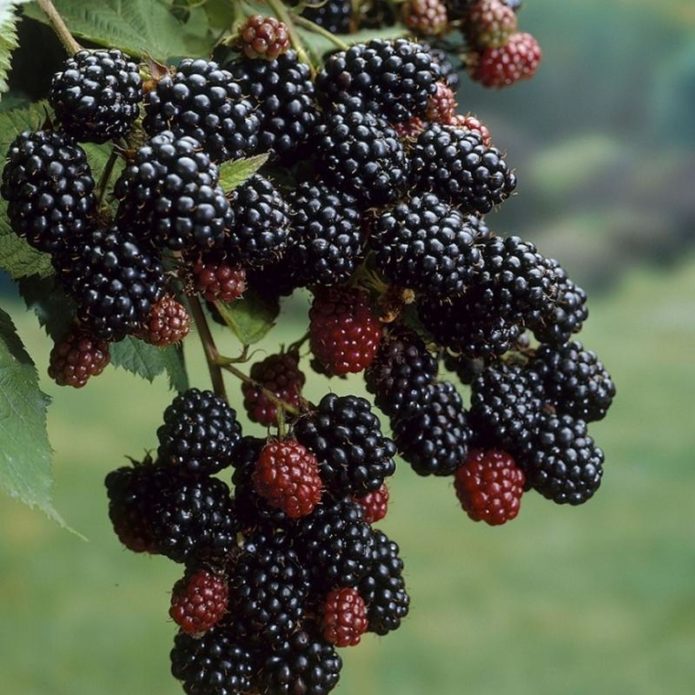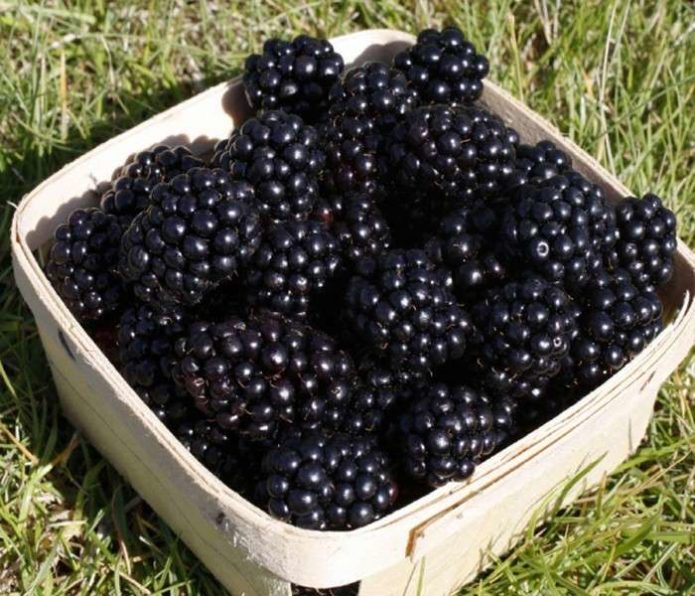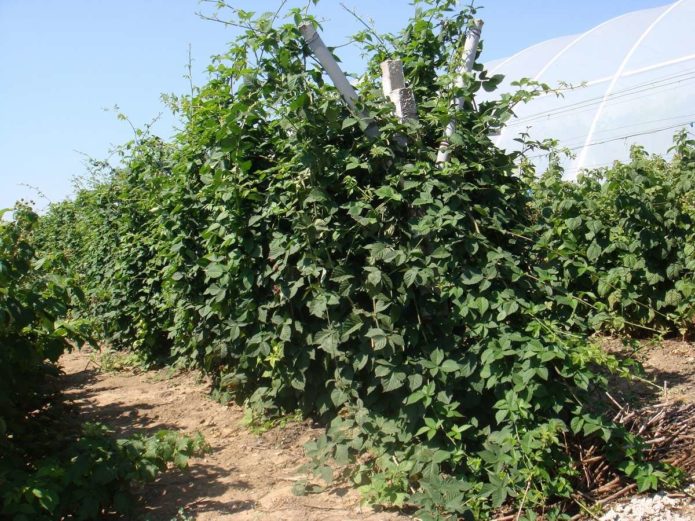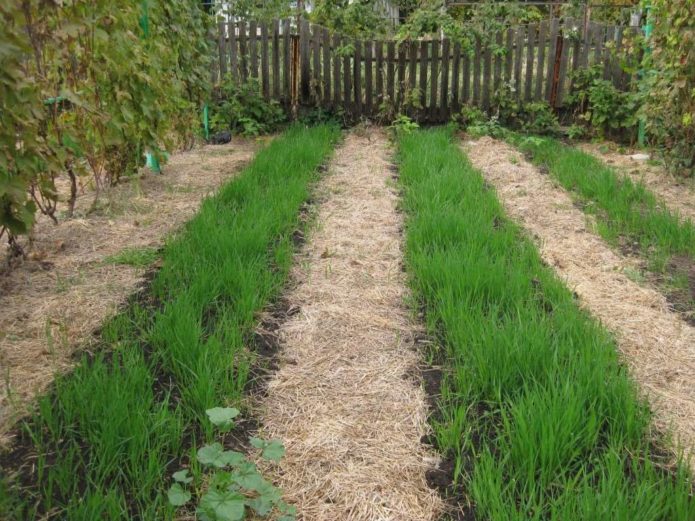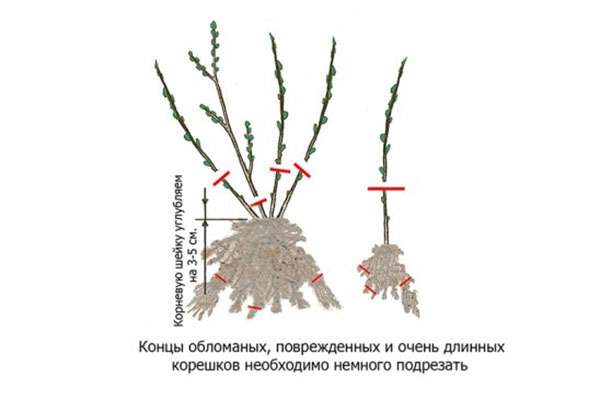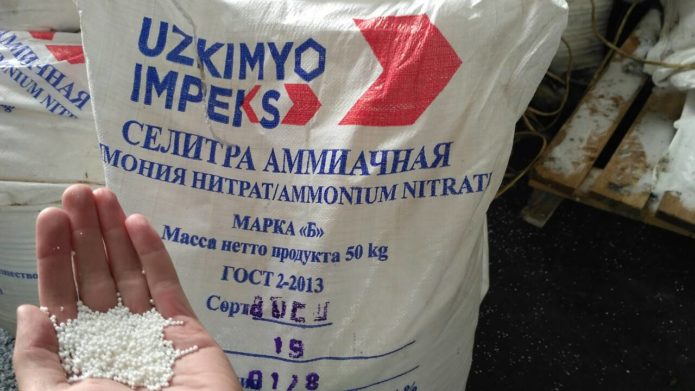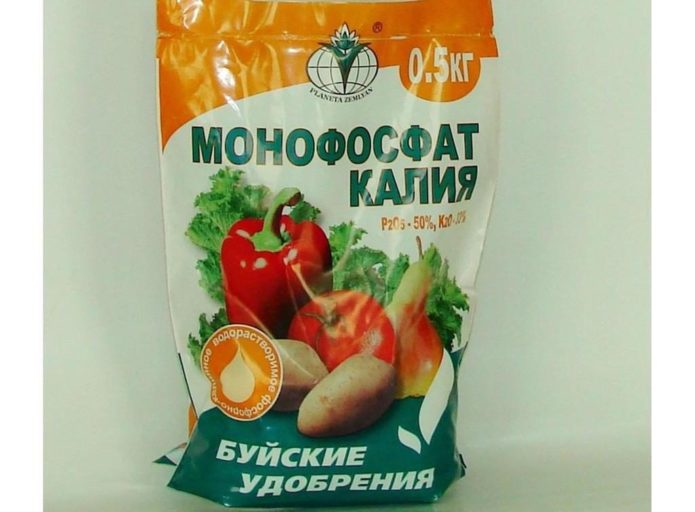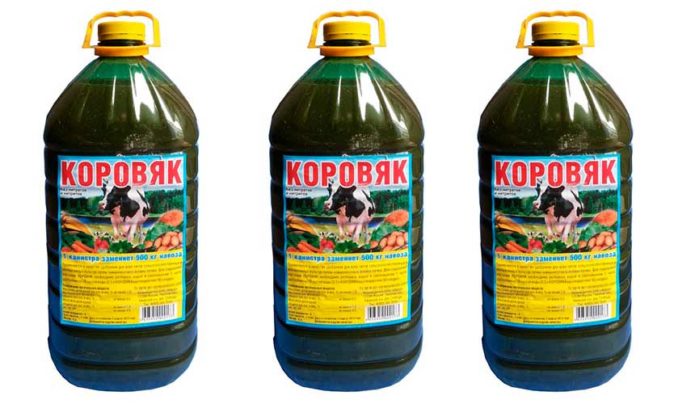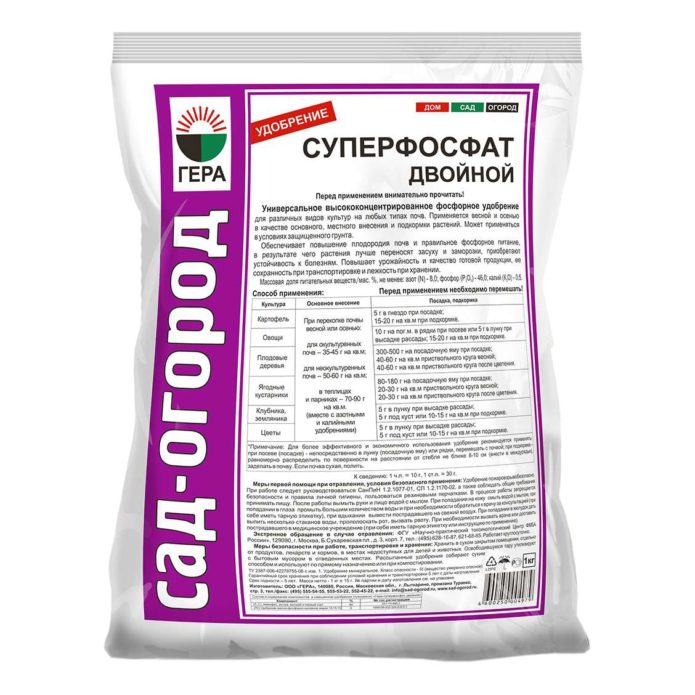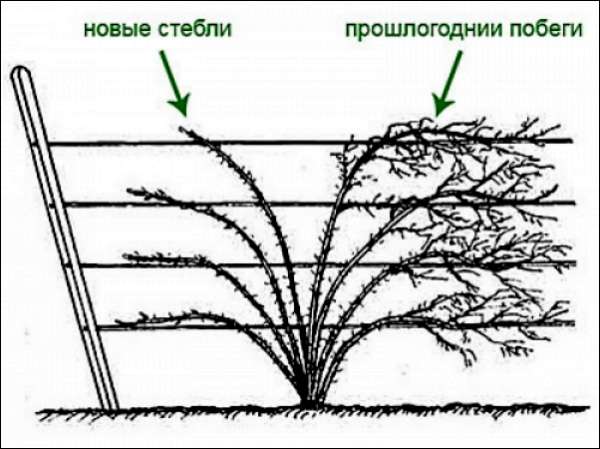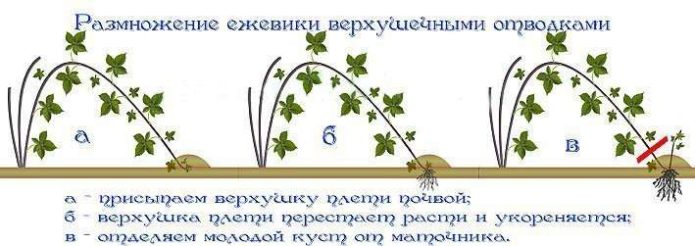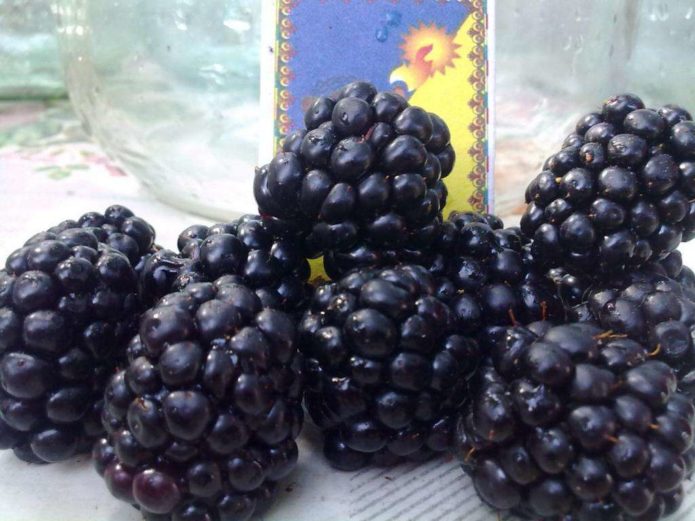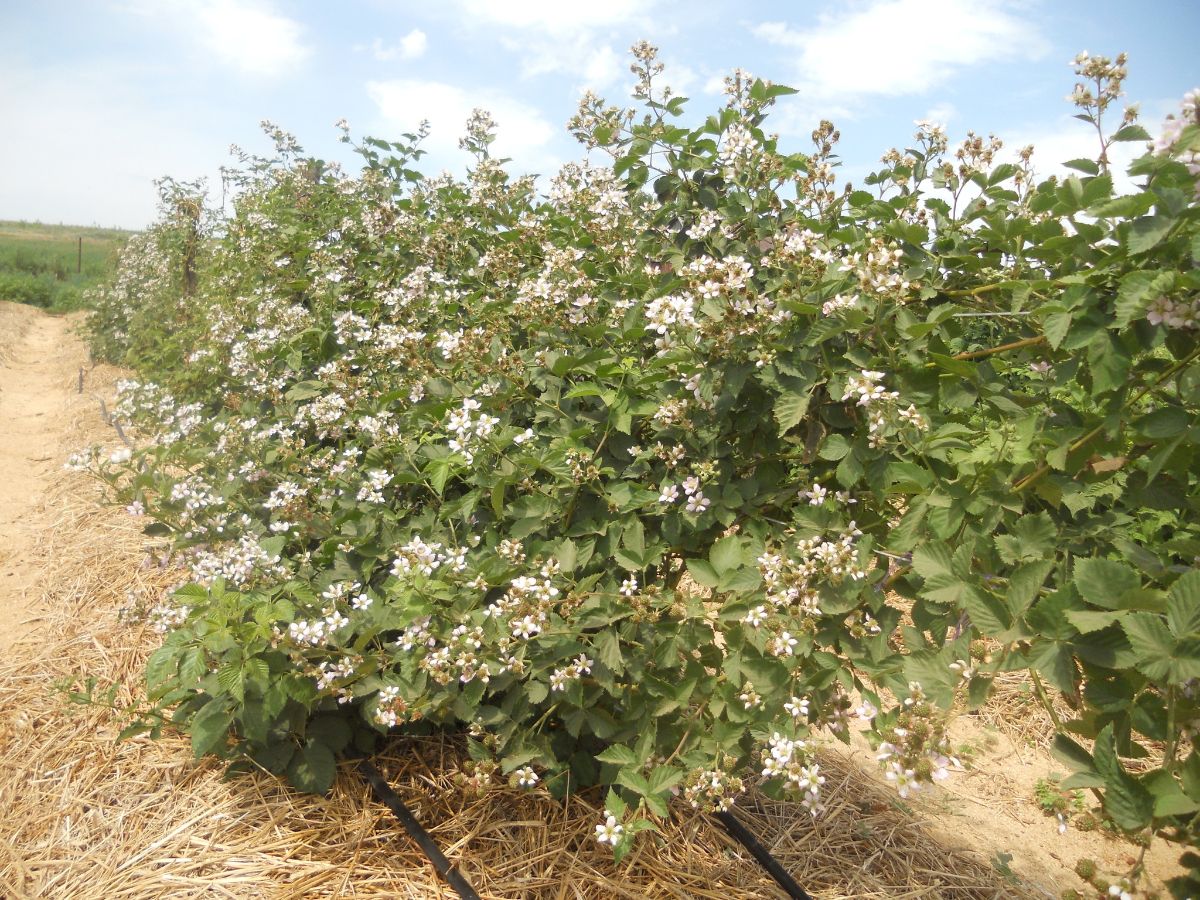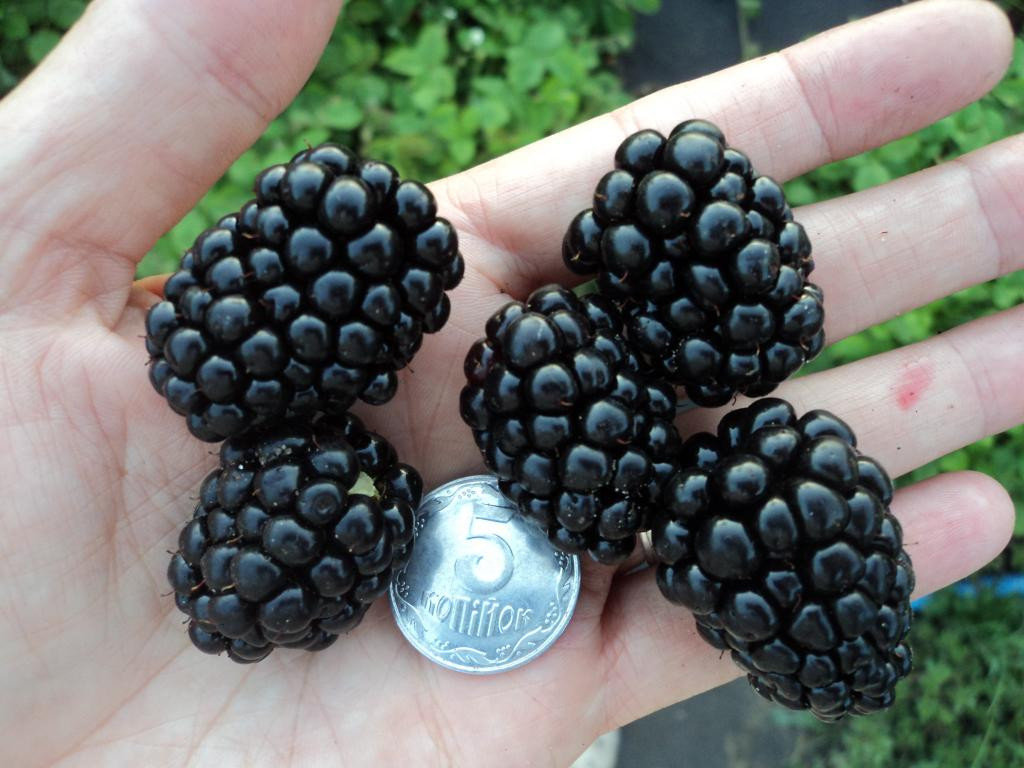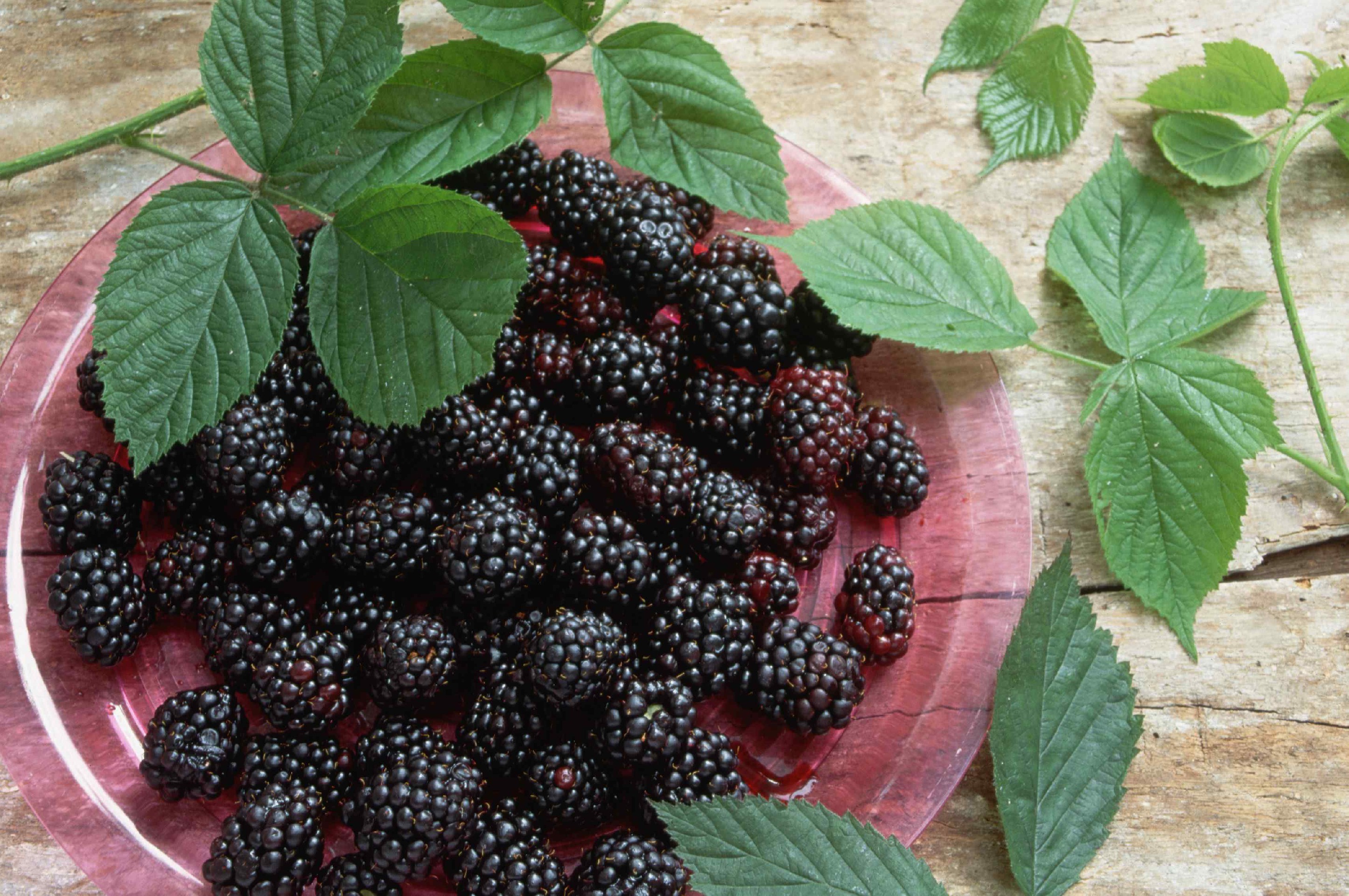Blackberries relatively recently began to appear in the gardens of residents of Russia. While this culture is not widespread enough. But those gardeners who nevertheless decided to allocate a place for her on the site do not regret it. One of the first cultivated blackberry varieties was Thornfree, which quickly gained popularity due to its high yield, total thornlessness and ease of maintenance. Our goal is to acquaint the gardener with this wonderful blackberry and clarify the features of its agricultural technology.
Content
History of breeding, description and characteristics of the blackberry variety Thornfrey
A variety from America, bred in 1966 by breeder Dr. Scott. The main difference from other varieties at that time determined its name. Literally translated, Thorn free means "free from thorns." Indeed, this shrub has thornless, smooth shoots. In Russia, this variety was registered in the State Register in 2006 and approved for cultivation in all regions. But we immediately note that in the conditions of the North-West and other cold regions it will not be possible to grow it due to its low frost resistance. The originator was the Samara Research Institute of Horticulture and Medicinal Plants "Zhiguli Gardens". A variety for dessert purposes, late ripening.
Semi-creeping shrub with powerful, thick shoots more than five meters long. From the base they are raised, then creeping. Flowering occurs in the first half of June, self-pollination is high. The flowers are large, bisexual, collected in inflorescences, have a delicate aroma. The ovaries are formed in large quantities and hold perfectly. Fruiting occurs on lateral branches, which are densely overgrown with two-year-old shoots. On one such branch, from forty to sixty, and sometimes more than one hundred berries are formed.
The thornless blackberry is a man-made culture that does not occur in nature. The best varieties and features of their cultivation:https://flowers.bigbadmole.com/en/yagody/sorta-ezheviki-besshipnoy.html
The frost resistance of the variety is insufficient; in relatively cold winters with temperatures below -18 ° C, it freezes annually. But the lateral shoots formed on the lower nodes of two-year-old shoots steadily save the situation. Drought resistance and heat resistance of the variety at altitude (although in too hot areas it can suffer from sunburn), immunity to diseases and pests - too. Sometimes it is attacked by mice and weevils, sometimes it is affected by gray rot.
The yield is high, on an industrial scale - an average of 77.8 c / ha. Gardeners, depending on the growing conditions and care, get from 15 to 25 kilograms of berries from one bush. Usually the crop is harvested from early August to early September. The berries are quite large - 4.5-5 grams or more, the shape is oval. Fully ripe berries are easily separated from the stalk. The color is almost black, glossy. When fully ripe, the surface becomes dull. The taste is sweet with a faint aroma. When fully ripe, aroma and taste improve, but density and transportability are lost. Tasting assessment of the taste of berries is 4 points, processed products - 3 points.
Advantages and disadvantages in comparison with similar
In the State Register, except for Thornfree, only two varieties of blackberries are registered - Agavam and Agatovaya. Let's compare their characteristics.
Table: advantages and disadvantages of Thornfrey blackberries in comparison with similar
| Blackberry variety | Advantages | disadvantages |
| Thornfree |
|
|
| Agave |
|
|
| Agate |
|
|
Video: Review of Thornfrey's two-year blackberry bush
Features of agricultural technology varieties of blackberry Thornfree
Thornfrey Blackberry is grown on a trellis 2.0-2.5 meters high with several rows of wire. The trellises should be prepared in advance, before planting. The distance between the rows of trellises is chosen within 2 - 2.5 meters.
Landing
Blackberries are planted in much the same way as raspberries. And it's better to do it in the spring. The sequence of actions is as follows:
- The planting site is prepared in the fall. It must meet certain requirements:
- Well-lit sunny place. In hot areas, planting in partial shade is possible.
- The place is level or on a small southern slope, protected from cold winds, which can be formed by dense trees, a fence, or a building wall.
- Groundwater should lie no closer than one and a half to two meters.
- The soil is required loose, light, fertile. Loams, sandy loams, chernozems with a neutral or slightly acidic reaction (pH 5.5 - 6.5) are suitable.
- You can not plant blackberries in areas where raspberries were previously grown, since they have common diseases and pests. And also do not place them in the neighborhood.
- A year before planting, it is advisable to plant green manures in the selected area, which are mowed in autumn and plowed into the soil along with fertilizers:
- humus or compost - 2-3 buckets per square meter;
- superphosphate - 30-40 g / m2;
- wood ash - 1-2 l / m2;
- fluff lime (if necessary to deoxidize the soil) - 500 g / m2.
- In early spring, before bud break, seedlings with an open root system are planted. For this:
- A few hours before planting, the roots of the seedlings are soaked in water. It is advisable to add growth stimulants such as Heteroauxin, Kornevin, Epin to the water.
- Dig holes in the rows with a diameter of 40-45 centimeters and the same depth.The distance between the holes is chosen within 3 - 4.5 meters, since the Thornfrey blackberry has rather powerful, long shoots. If it is supposed to use short pruning of shoots, then the distance between the holes is reduced to one or two meters.
- In addition to the fertilizers introduced in the fall, 0.5 buckets of humus and 150 grams of superphosphate should be poured into each hole, and then mixed with the prepared soil.
- Seedlings are planted in the holes, deepening the root collar by 3-5 centimeters. Before planting, long and damaged roots are cut off, and the shoots are cut to two buds.
- They form near-trunk circles, water and mulch abundantly.
Blackberry seedlings with a closed root system can be planted at any time of the season - from April to October.
For beginners or experienced gardeners faced with a new culture, it is useful to know some secrets of planting and transplanting blackberries:https://flowers.bigbadmole.com/en/yagody/posadka-ezheviki-vesnoy.html
Care
Thornfrey blackberry care is simple. Gardeners note that even without leaving, it gives a pretty decent harvest. Well, if you make some effort, the results can be impressive. It is especially important to provide proper care for the first three years after planting.
Watering and feeding
Plants experience the greatest need for watering in the spring, during the flowering period and the formation of the ovary. And you also need moisture during the growth and ripening of berries. But after harvesting, watering is reduced, allowing one-year shoots to ripen and lignify. Before leaving for the winter, abundant water-charging watering is carried out. After watering, the soil must be loosened. It is very cool if there is an opportunity to mulch it with humus, compost, rotted sawdust, etc.
Blackberries are fed in the same way as raspberries. The usual scheme is as follows:
- In the spring it is watered with urea or ammonium nitrate dissolved in water. Consumption rate - 20-30 g / m2.
- In June, potash fertilizers are applied in the same way at a rate of 10-20 g / m2... It is better to use potassium monophosphate for this.
- With the beginning of the formation of ovaries and the growth of berries, 2-4 fertilizing (interval 10-15 days) with liquid organic fertilizers is carried out. To do this, prepare an infusion of mullein in warm water in a ratio of 2 to 10 (you can use bird droppings in a ratio of 1 to 10). After a week, the solution is filtered and used for irrigation, diluting with water 1 to 10. The approximate consumption of the concentrate is 1 l / m2.
- In autumn, superphosphate is introduced under the digging at a rate of 30-40 g / m2.
Pruning and shaping, shelter for the winter
For this variety, which has powerful bushes, one-sided shaping is used. It lies in the fact that the shoots of the current year are directed in one direction from the center of the bush, and two-year-olds are directed to the other. In this order, they are tied up on a trellis, where they are located until autumn.
Another method of shaping is suitable for those who do not want or cannot tie blackberries to tall trellises. In this case, young shoots are pinched when they reach a height of sixty centimeters. As a result, other shoots grow from the leaf axils, which also pinch at a length of 50 centimeters. Since the lower part of the plant is thicker, it will be problematic to bend it down in the fall for shelter. Obviously, this method is suitable for gardeners in the southern regions, where blackberries are not covered.
After harvesting, last year's fruit-bearing shoots are cut and burned, and the ripe annuals are removed from the trellis, laid on the ground (it is advisable to put something: boards, hay, spruce branches) and sheltered for the winter. You can tie the shoots horizontally above the ground, then arcs are installed above them and covered with spunbond. The most difficult thing is to cover the "head" of the bush, that is, the base of the shoots. Since they are very thick and do not bend well, they can be broken by bending them to the ground. Therefore, some gardeners prefer to pinch young shoots in the spring in order to get lateral, more flexible and pliable ones. In the southern regions with mild winters, plants can be left uncovered or even removed from the trellis.
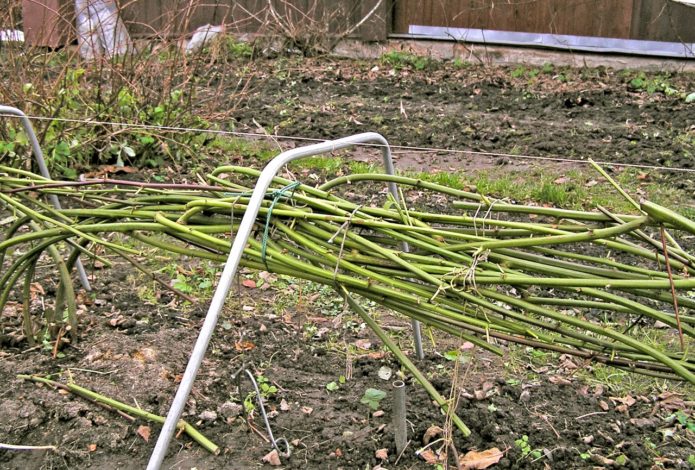
You can cover the blackberries with spunbond for the winter, after tying the shoots and installing arcs
Prevention of diseases and pests
Since, subject to the rules of agricultural technology, the variety is little susceptible to diseases and pest attacks, then with growing blackberries you just need to follow certain measures of general prevention and sanitation. A short list of them:
- In autumn, dig deeply (plow) the soil of the root space with the overturn of the layers.
- Collect and dispose of fallen leaves and weeds.
- Evenly lay out poisonous baits against mice under the shelter of the bushes.
- In early spring, after opening the bushes, carry out preventive treatment against pests and diseases with a 3% solution of copper sulfate or Bordeaux liquid.
- Do not allow the plantings to thicken and create dampness in them.
- Do not allow weeds to clog the area, removing them in a timely manner.
Reproduction
Blackberry Thornfrey gives few shoots and almost all of them are used to replace those that bear fruit. Fortunately, it reproduces easily in other ways.
Propagation of Thornfrey blackberries by apical layers
This is the easiest and most popular way. To grow a seedling, in mid-July - early August, you just need to dig into the hole the top of the young shoot along with the leaves.
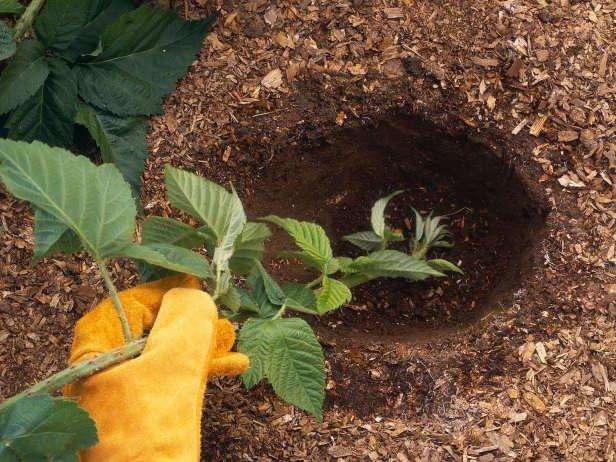
To grow a seedling in late July-early August, you just need to dig into the hole the top of the young shoot along with the leaves
Then they pin it for reliability with a wire pin and regularly watered with water. The dug-in tip will quickly take root. After 1.5-2 months, around the second half of September, she will already have good fibrous roots. At this time, it is separated from the mother bush - the seedling is ready. You can leave it in this place if it suits the gardener, and you can also transplant a seedling or lay it in storage until spring.
Alternatively, rooting the top of the shoot in a container or pot with nutritious soil. The result will be a seedling with a closed root system.
Video: reproduction of Thornfrey blackberries with apical layers
Blackberry propagation by cuttings, an overview of the best methods and recommendations:https://flowers.bigbadmole.com/en/yagody/razmnozhenie-ezheviki-cherenkami.html
Propagation of Thornfrey blackberries by rooting part of the shoot in two containers
For reproduction in this way, at the junction of July and August, cuttings are cut from the tops of the shoots about 60 centimeters long. Prepare two containers (pots) with the nutrient mixture and place them side by side. The top of the cutting, together with the leaves, is dropped into one of the containers, and the base into the other. The digging depth of both ends should be 15–20 centimeters.
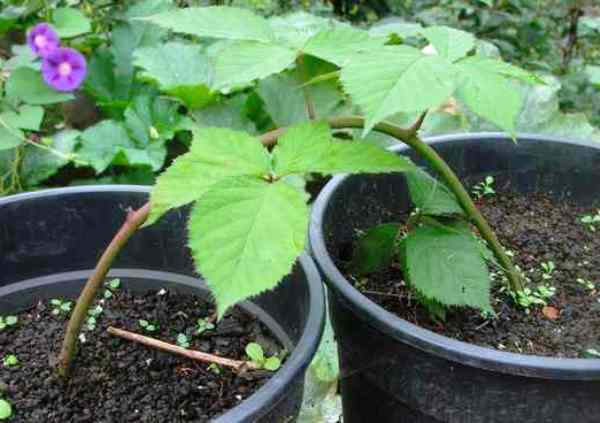
The top of the cutting, together with the leaves, is dropped into one of the containers, and the base into the other
The containers are placed in a shaded area and watered regularly. After one and a half - two months, the seedlings are separated from each other. The one that is formed by the apical part already has a good root system and is ready for planting. On the second, no roots have yet formed, but there should be a powerful callus, from which the roots will grow by spring.
In plant biology, callus is called the cells that form on the wound surface of a plant in the form of corky tissue, which arises from the division of cells bordering on the wound.
Blackberry propagation by green cuttings
Green cuttings of Thornfrey blackberry root perfectly and in this way you can get quite a lot of planting material. To do this, in the summer, young shoots are cut and cuttings are cut from them. On each of them, one upper sheet is left, and the two lower ones are cut off. Cuttings are inserted into prepared containers with soil with the lower part so that the bases of the trimmed lower leaves with buds are in the ground.

Thornfree's green blackberry blackberries take root well and thus you can get quite a lot of planting material.
After that, the containers are placed in a slightly shaded place and covered with a transparent film to create high humidity. The soil is regularly watered from a spray bottle, and the temperature under the film is also monitored. It shouldn't be too high. The optimum temperature is 25-28 ° C. After about two weeks, when the cuttings take root, the shelter can be removed.
Gardeners reviews
Review: Blackberry variety "Thornfree" - unpretentious, tasty, noble. The variety differs from other blackberry varieties in the absence of thorns, unpretentiousness and very high yield, large berry size. It turns out that blackberries are healthier than raspberries! The cultivar was advised to me by a novice gardener in the Rostok agricultural company as "not killed". A seedling with a closed root system, planted in early summer, by the fall gave 6 five-meter semi-rigid shoots, which we tied to a wire trellis, raising them above the ground. For the winter they took it off, turned it into a wide ring, laid it on the boards and covered it. In the spring, they raised the overwintered whips again on the trellis - they bloomed along the entire length of the shoots with beautiful pink tassels. There were a lot of flowers. The formed berry clusters did not ripen at the same time, it was necessary to do a selective collection. Ripe berries are very sweet, aromatic, slightly tart and easily separated from the stalk, transportable, the size of a finger phalanx. If given to overripe, they become watery and creep up ... They ripen from the beginning of August until frost ... Very tasty jelly, liqueur, compotes are made from the berries ... Over the summer, new shoots grow, which we leave for the winter, and cut off those that bear fruit. And that's all. A wonderful berry and a wonderful variety.
Tornfree
I want to note that I got the harvest without much care (all my strength was thrown into the vineyard). They covered it with straw for the winter - the blackberry did not freeze, but it was pretty spoiled by mice. This year they covered it with polypropylene bags on frames and put the poison in plastic bottles, spring will come - we'll see. Watering - once a month (in such a heat!), The aisles are tinned (mowed once a month), the trellis is a thread stretched between meter pegs. Of course, I didn't get a huge harvest and very large berries, but it was enough to eat and preserve. Naturally, with good care, the harvest will be larger and the berries are larger and sweeter, but those who have a time limit or a remote land plot will not be left without a crop either.
On my site, the branches grow much longer, 5 m is the norm. The variety is very productive, this year 34 kg of berries were obtained from 1 Thornfree bush.
I have been growing the Thornfree variety for over 10 years. Very vigorous and productive. Responsive to care, loves watering and feeding. I have planted a row of 40 m, there are 18 bushes in it. Perfectly reconciles with partial shade, we really like the taste and with the berry there are no problems in implementation. In winter, everything above the snow cover freezes. Mice are very fond of gnawing buds in winter. Last winter, the whole row froze, in the spring I cut everything off at the soil level and mulched it with straw, did 3-4 abundant watering, at the end of July it began to grow back, the bramble was saved!
Re: Thornfree
In my conditions, it is not completely problem-free, but also not labor-intensive variety. It is necessary to cover in the winter, however, very carefully.Well, a lot of berries go unripe in winter, but enough to eat from the heart.
Re: Thornfree
During the ripening period of the berries, I water it very abundantly (15–20 minutes with good pressure under each bush) once a week (in extreme heat, 2 times).
Best regards, Marina Vladimirovna.
Re: Thornfree
Hello everyone! In my conditions, the variety is really problem-free: at the beginning of spring, a bucket of humus under a bush, immediately mulch (cardboard, fiberboard, pieces of an old car chamber in an emergency) and water during the ripening period, this must be monitored carefully, because with a lack of moisture in dry summer part of the crop may dry out on the bush. The only trouble is that ants will surely start under the mulch, but this can be neglected, because compared to the control bushes, the yield increases by about 40 percent + the quality of the berries is beyond comparison. For the winter I never cover and do not bend down - I am lazy, I did not notice any failures in productivity. I shape it with a bush. I also did not notice the influence of a large harvest on growth (I have been growing it for more than 10 years), in any case rushing so that only have time to pinch. In general - a fairy tale! But in fairness, I would like to note that neither taste nor aroma can compare with the wild ogina that grows on the slopes in the foothills.
The Thornfree variety makes a very aromatic wine! And not only fragrant, but also damn delicious! Last year I made 3 liters - it took off. And in this a little over 20, using ČKD QA23 and adding 300 g of honey per liter of juice, fermented for 2.5 months. A month ago, I added oak chips from our tyrnet store - the test was excellent (especially for a barbecue, not for chess). I am not a wine guru, but the result is a dessert wine, quite strong, aromatic and very tasty. And, most importantly, everyone loved him! Last year, looking at this, I planted 20 more bushes.
Despite the fact that nowadays new progressive varieties of blackberries are already appearing, Thornfree does not lose popularity. Its yield, rather pleasant taste of berries and their large size, resistance to disease, heat and drought, allow Thornfrey to remain in the group of leaders. The variety is great for beginner gardeners, since caring for it does not require significant effort and time.
